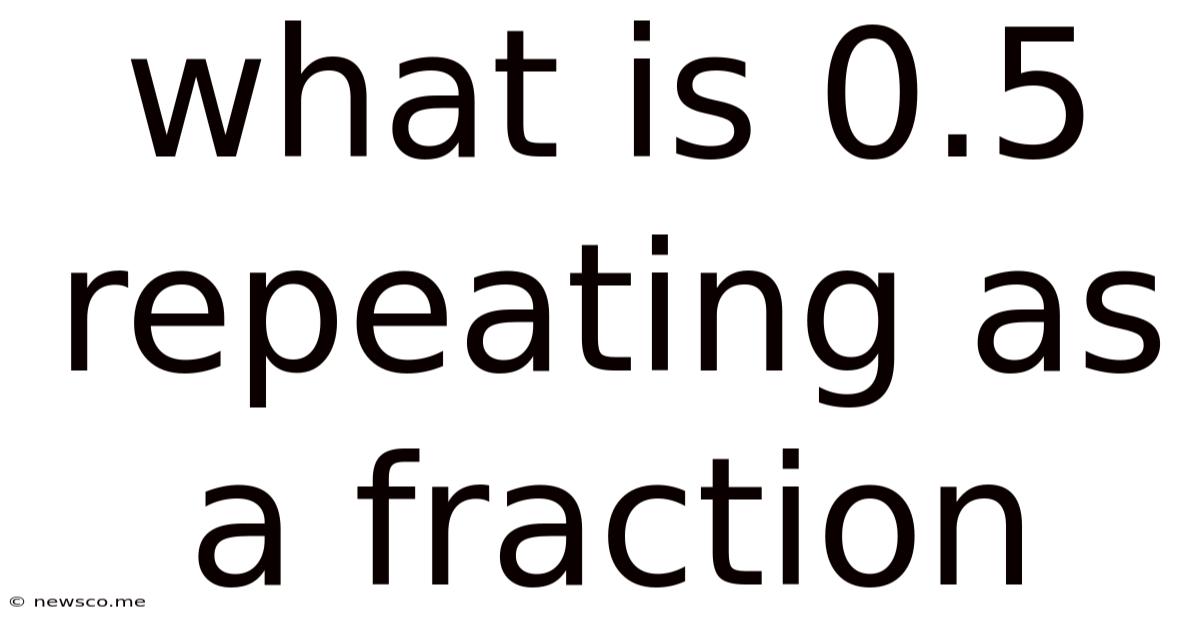What Is 0.5 Repeating As A Fraction
News Co
Mar 28, 2025 · 4 min read

Table of Contents
What is 0.5 Repeating as a Fraction? A Deep Dive into Decimal-to-Fraction Conversion
The question "What is 0.5 repeating as a fraction?" might seem deceptively simple at first glance. However, understanding how to convert repeating decimals into fractions requires a grasp of fundamental mathematical concepts and a systematic approach. This comprehensive guide will not only answer this specific question but also equip you with the knowledge to tackle similar conversions effectively. We'll explore different methods, delve into the underlying principles, and solidify your understanding with numerous examples.
Understanding Repeating Decimals
Before tackling the conversion, let's clarify what "repeating decimal" means. A repeating decimal, also known as a recurring decimal, is a decimal number that has a digit or a group of digits that repeat infinitely. These repeating digits are often indicated with a bar over them. For example:
- 0.333... is written as 0.3̅ (the 3 repeats infinitely)
- 0.142857142857... is written as 0.142857̅ (the sequence 142857 repeats infinitely)
Our specific question involves "0.5 repeating". However, the number 0.5 doesn't have any repeating digits. It terminates. Therefore, the question, as written, is somewhat ambiguous. We'll explore two interpretations:
Interpretation 1: 0.5 as a Fraction (Terminating Decimal)
If the question is asking for the fraction representation of the terminating decimal 0.5, the solution is straightforward:
0.5 represents 5 tenths, which can be written as the fraction 5/10. This fraction can then be simplified by dividing both the numerator (5) and the denominator (10) by their greatest common divisor (GCD), which is 5:
5 ÷ 5 / 10 ÷ 5 = 1/2
Therefore, 0.5 expressed as a fraction is 1/2.
Interpretation 2: Addressing Possible Ambiguity (Misinterpretation of Repeating Decimal)
It's possible that the question mistakenly implies a repeating decimal. Let's assume the question meant a number like 0.555... (0.5̅). This is a very different scenario, involving a repeating decimal. Let's explore how to convert this to a fraction.
Method 1: Using Algebra to Solve Repeating Decimals
This method uses algebraic manipulation to solve for the fraction representation of a repeating decimal. Let's use 0.5̅ as our example:
-
Let x = 0.5̅ This assigns a variable to the repeating decimal.
-
Multiply by a power of 10: Since only one digit repeats, we multiply both sides of the equation by 10:
10x = 5.5̅
-
Subtract the original equation: Subtract the equation from step 1 from the equation in step 2:
10x - x = 5.5̅ - 0.5̅
This simplifies to:
9x = 5
-
Solve for x: Divide both sides by 9:
x = 5/9
Therefore, 0.5̅ (or 0.555...) expressed as a fraction is 5/9.
Method 2: Using the Formula for Repeating Decimals
A more general approach involves using a formula to convert repeating decimals to fractions. For a decimal with a repeating block of 'n' digits, the formula is:
Fraction = Repeating Block / (10<sup>n</sup> - 1)
Where:
- Repeating Block is the repeating digits (as an integer)
- n is the number of repeating digits
Let's apply this to 0.5̅:
- Repeating Block: 5
- n: 1 (only one digit repeats)
Fraction = 5 / (10<sup>1</sup> - 1) = 5 / (10 - 1) = 5/9
Again, we arrive at the fraction 5/9.
Examples of Converting Repeating Decimals to Fractions
Let's solidify our understanding with more examples:
Example 1: 0.3̅
Using the formula:
- Repeating Block: 3
- n: 1
Fraction = 3 / (10<sup>1</sup> - 1) = 3/9 = 1/3
Example 2: 0.6̅3̅
Using the formula:
- Repeating Block: 63
- n: 2
Fraction = 63 / (10<sup>2</sup> - 1) = 63 / 99 = 7/11
Example 3: 0.142857̅
Using the formula:
- Repeating Block: 142857
- n: 6
Fraction = 142857 / (10<sup>6</sup> - 1) = 142857 / 999999 = 1/7 (after simplification)
Strategies for Simplifying Fractions
Once you've converted a repeating decimal to a fraction, you'll often need to simplify the fraction to its lowest terms. This involves finding the greatest common divisor (GCD) of the numerator and denominator and dividing both by the GCD. You can use methods like prime factorization or the Euclidean algorithm to find the GCD.
Conclusion: Mastering Decimal-to-Fraction Conversions
Converting repeating decimals to fractions may seem challenging initially, but with a systematic approach and the understanding of the underlying principles, it becomes a manageable task. Both the algebraic method and the formula provide effective pathways to solve these types of problems. Remember to always simplify your final fraction to its lowest terms. This guide has provided you with the tools and examples needed to confidently tackle any repeating decimal-to-fraction conversion. Practice is key – the more you work through examples, the more proficient you’ll become.
Latest Posts
Related Post
Thank you for visiting our website which covers about What Is 0.5 Repeating As A Fraction . We hope the information provided has been useful to you. Feel free to contact us if you have any questions or need further assistance. See you next time and don't miss to bookmark.